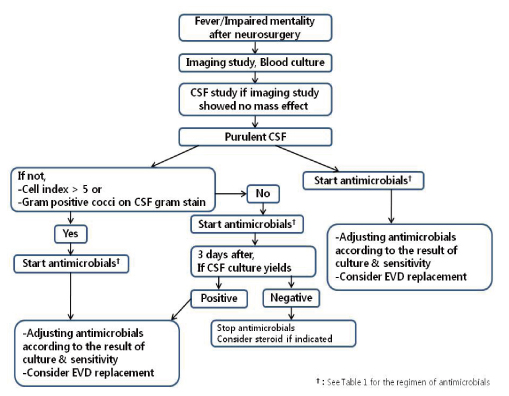Infect Chemother.
2011 Jun;43(3):229-233. 10.3947/ic.2011.43.3.229.
Infectious Complications after Neurosurgery: Mainly Focusing on Ventriculitis and Meningitis
- Affiliations
-
- 1Department of Internal Medicine, The Catholic University of Korea, College of Medicine, Seoul, Korea. jhyoo@catholic.ac.kr
- KMID: 2170342
- DOI: http://doi.org/10.3947/ic.2011.43.3.229
Abstract
- Ventriculitis and nosocomial meningitis are major infectious complications after neurosurgery. Determining whether fever after neurosurgery is infectious origin or not should be meticulously performed. Cell index >5 could be a reliable parameter for the decision to empirical treatment before microbiological documentation. Antimicrobials should be prudently chosen on the basis of risk factors (craniotomy, ventricular catheterization, trauma such as basal skull fracture) and of the pharmacokinetic properties along with blood-brain-barrier (BBB) permeability. Antimicrobials which have poor permeability to the BBB, glycopeptide as an example, could be administered via intrathecal route. If microbiological documentation is obtained after empirical treatment, the regimen should be adjusted according to the result of culture and sensitivity.
Keyword
Figure
Reference
-
1. Yoo JH. Infectious diseases in the field of neurosurgery. Korean J Med. 2003. 65:S567–S573.2. Horan TC, Andrus M, Dudeck MA. CDC/NHSN surveillance definition of health care-associated infection and criteria for specific types of infections in the acute care setting. Am J Infect Control. 2008. 36:309–332.
Article3. van de Beek D, Drake JM, Tunkel AR. Nosocomial bacterial meningitis. N Engl J Med. 2010. 362:146–154.
Article4. Lozier AP, Sciacca RR, Romagnoli MF, Connolly ES Jr. Ventriculostomy-related infections: a critical review of the literature. Neurosurgery. 2008. 62:Suppl 2. 688–700.
Article5. Bota DP, Lefranc F, Vilallobos HR, Brimioulle S, Vincent JL. Ventriculostomy-related infections in critically ill patients: a 6-year experience. J Neurosurg. 2005. 103:468–472.
Article6. Korinek AM, Baugnon T, Golmard JL, van Effenterre R, Coriat P, Puybasset L. Risk factors for adult nosocomial meningitis after craniotomy: role of antibiotic prophylaxis. Neurosurgery. 2006. 59:126–133. discussion 126-33.
Article7. McClelland S 3rd, Hall WA. Postoperative central nervous system infection: incidence and associated factors in 2111 neurosurgical procedures. Clin Infect Dis. 2007. 45:55–59.
Article8. Beer R, Lackner P, Pfausler B, Schmutzhard E. Nosocomial ventriculitis and meningitis in neurocritical care patients. J Neurol. 2008. 255:1617–1624.
Article9. Conen A, Walti LN, Merlo A, Fluckiger U, Battegay M, Trampuz A. Characteristics and treatment outcome of cerebrospinal fluid shunt-associated infections in adults: a retrospective analysis over an 11-year period. Clin Infect Dis. 2008. 47:73–82.
Article10. Vinchon M, Dhellemmes P. Cerebrospinal fluid shunt infection: risk factors and long-term follow-up. Childs Nerv Syst. 2006. 22:692–697.
Article11. Beer R, Pfausler B, Schmutzhard E. Infectious intracranial complications in the neuro-ICU patient population. Curr Opin Crit Care. 2010. [Epub ahead of print].
Article12. Pfausler B, Beer R, Engelhardt K, Kemmler G, Mohsenipour I, Schmutzhard E. Cell index--a new parameter for the early diagnosis of ventriculostomy (external ventricular drainage)-related ventriculitis in patients with intraventricular hemorrhage? Acta Neurochir (Wien). 2004. 146:477–481.
Article13. Zarrouk V, Vassor I, Bert F, Bouccara D, Kalamarides M, Bendersky N, Redondo A, Sterkers O, Fantin B. Evaluation of the management of postoperative aseptic meningitis. Clin Infect Dis. 2007. 44:1555–1559.
Article14. Leib SL, Boscacci R, Gratzl O, Zimmerli W. Predictive value of cerebrospinal fluid (CSF) lactate level versus CSF/blood glucose ratio for the diagnosis of bacterial meningitis following neurosurgery. Clin Infect Dis. 1999. 29:69–74.
Article15. Ziai WC, Lewin JJ 3rd. Improving the role of intraventricular antimicrobial agents in the management of meningitis. Curr Opin Neurol. 2009. 22:277–282.
Article16. Tunkel AR, Hartman BJ, Kaplan SL, Kaufman BA, Roos KL, Scheld WM, Whitley RJ. Practice guidelines for the management of bacterial meningitis. Clin Infect Dis. 2004. 39:1267–1284.
Article17. . The management of neurosurgical patients with postoperative bacterial or aseptic meningitis or external ventricular drain-associated ventriculitis. Infection in Neurosurgery Working Party of the British Society for Antimicrobial Chemotherapy. Br J Neurosurg. 2000. 14:7–12.18. O'Malley MR, Haynes DS. Assessment and management of meningitis following cerebellopontine angle surgery. Curr Opin Otolaryngol Head Neck Surg. 2008. 16:427–433.19. Kim BN, Peleg AY, Lodise TP, Lipman J, Li J, Nation R, Paterson DL. Management of meningitis due to antibiotic-resistant Acinetobacter species. Lancet Infect Dis. 2009. 9:245–255.
Article20. Hong YA, Yoo JH, Kim JJ, Mo EY, Ahn GH, Jeong HK, Kim JS, Lee HJ, Jung MH, Yoon SB. A case of multidrug-resistant Acinetobacter baumannii ventriculitis successfully treated with intrathecal colistimethate. Infect Chemother. 2009. 41:240–244.
Article21. Rodríguez Guardado A, Blanco A, Asensi V, Pérez F, Rial JC, Pintado V, Bustillo E, Lantero M, Tenza E, Alvarez M, Maradona JA, Cartón JA. Multidrug-resistant Acinetobacter meningitis in neurosurgical patients with intraventricular catheters: assessment of different treatments. J Antimicrob Chemother. 2008. 61:908–913.
Article22. Dalgic N, Ceylan Y, Sancar M, Telhan L, Kafadar I, Cavusoglu H, Ceylan O, Hasim O. Successful treatment of multidrug-resistant Acinetobacter baumannii ventriculitis with intravenous and intraventricular colistin. Ann Trop Paediatr. 2009. 29:141–147.
Article23. Katragkou A, Roilides E. Successful treatment of multidrug-resistant Acinetobacter baumannii central nervous system infections with colistin. J Clin Microbiol. 2005. 43:4916–4917.
Article
- Full Text Links
- Actions
-
Cited
- CITED
-
- Close
- Share
- Similar articles
-
- Pneumoncoccal Meningitis Presenting with Ventriculitis and Pneumocephalus
- A clinical study on neonatal bacterial meningitis
- A Case of Pyogenic Ventriculitis Complicating Obstruction of Aqueduct of Sylvius
- Intraventricular Antimicrobial Therapy for Intractable Ventriculitis: Two Case Reports
- A Case of External Ventricular Drain-related Ventriculitis: Implementation of a Standardized Bundle to Prevent Infection


